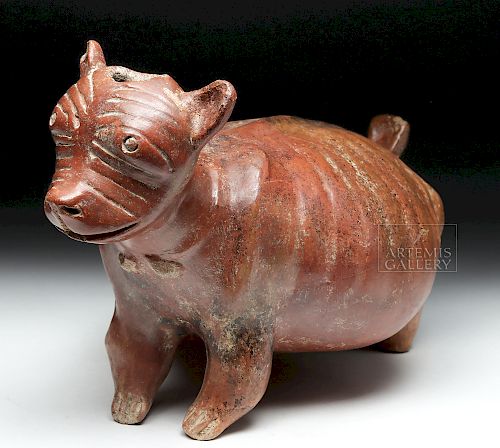Nayarit Chinesco Pottery Redware Emaciated Dog Vessel
Lot 12a
About Seller
Artemis Fine Arts
686 S Taylor Ave, Ste 106
Louisville, CO 80027
United States
Selling antiquities, ancient and ethnographic art online since 1993, Artemis Gallery specializes in Classical Antiquities (Egyptian, Greek, Roman, Near Eastern), Asian, Pre-Columbian, African / Tribal / Oceanographic art. Our extensive inventory includes pottery, stone, metal, wood, glass and textil...Read more
Estimate:
$1,500 - $2,000
Absentee vs Live bid
Two ways to bid:
- Leave a max absentee bid and the platform will bid on your behalf up to your maximum bid during the live auction.
- Bid live during the auction and your bids will be submitted real-time to the auctioneer.
Bid Increments
| Price | Bid Increment |
|---|---|
| $0 | $25 |
| $300 | $50 |
| $1,000 | $100 |
| $2,000 | $250 |
| $5,000 | $500 |
| $10,000 | $1,000 |
| $20,000 | $2,500 |
| $50,000 | $5,000 |
| $100,000 | $10,000 |
| $200,000 | $20,000 |
About Auction
By Artemis Fine Arts
May 10, 2018
Set Reminder
2018-05-10 10:00:00
2018-05-10 10:00:00
America/New_York
Bidsquare
Bidsquare : Fine Ethnographic / Asian / Ancient Art
https://www.bidsquare.com/auctions/artemis-gallery/fine-ethnographic-asian-ancient-art-3213
Featuring antiquities from around the world including Pre-Columbian, Tribal, Classical, Asian, so much more! Artemis Fine Arts info@artemisgallery.com
Featuring antiquities from around the world including Pre-Columbian, Tribal, Classical, Asian, so much more! Artemis Fine Arts info@artemisgallery.com
- Lot Description
Pre-Columbian, Western Mexico, Nayarit, Chinesco style, Protoclassic period, ca. 100 BCE to 250 CE. A hand-built redware pottery vessel depicting a standing canine companion. The dog is heavily emaciated, with exposed ribs, a wrinkled face, and a visible spinal column. Standing upon four tubular legs, the animal's abdomen has a rotund shape despite its malnourished appearance. The morose countenance is comprised of almond-shaped eyes with incised pupils, a petite nose, pointed ears, and a thin smile, with a tab-shaped tail capping its posterior. It wears a double-beaded collar around its thick neck, and an ovoid hole perforates the head. Covered in a lustrous red-orange slip, this is a rare example of a Chinesco-style dog! Size: 12" L x 7" W x 8" H (30.5 cm x 17.8 cm x 20.3 cm).
Dogs in Nayarit culture were seen as both companion animals as well as creatures that were fattened up to be eaten, and were deeply-related to mythology surrounding the Underworld - seen as guides for the deceased into the afterlife. This style of sculpture is known as Chinesco by collectors because of its stylistic similarities to Chinese art. Clay figures like this one are the only remains that we have today of a sophisticated and unique culture in West Mexico -- they made no above-ground monuments or sculptures, at least that we know of, which is in strong contrast to developments elsewhere in ancient Mesoamerica. Instead, their tombs were their lasting works of art: skeletons arrayed radially with their feet positioned inward, and clay offerings, like this one, placed alongside the walls facing inward, near the skulls. A large effigy like this one would most likely have flanked the entrance to a tomb in a way that archaeologists have interpreted as guarding. Some scholars have connected these dynamic sculptures of the living as a strong contrast to the skeletal remains whose space they shared, as if they mediated between the living and the dead.
Provenance: private New York, New York, USA collection; ex-private Nevada, USA collection, acquired in the late 1990s; ex-Dr. David Harner collection, Arkansas, USA, acquired in 1950s to 1960s, collection #AA. 12
All items legal to buy/sell under U.S. Statute covering cultural patrimony Code 2600, CHAPTER 14, and are guaranteed to be as described or your money back.
A Certificate of Authenticity will accompany all winning bids.
We ship worldwide and handle all shipping in-house for your convenience.
#133032Vessel repaired from multiple pieces with some areas of restoration with resurfacing and overpainting along break lines. Surface wear commensurate with age, small chips to legs, ears, body, and tail, with some discoloration and fading to slip color, otherwise excellent. Nice earthen and mineral deposits throughout.Condition
- Shipping Info
-
All shipping is handled in-house for your convenience. Your invoice from Artemis Gallery will include shipping calculation instructions. If in doubt, please inquire BEFORE bidding for estimated shipping costs for individual items.
-
- Buyer's Premium



 EUR
EUR CAD
CAD AUD
AUD GBP
GBP MXN
MXN HKD
HKD CNY
CNY MYR
MYR SEK
SEK SGD
SGD CHF
CHF THB
THB


















